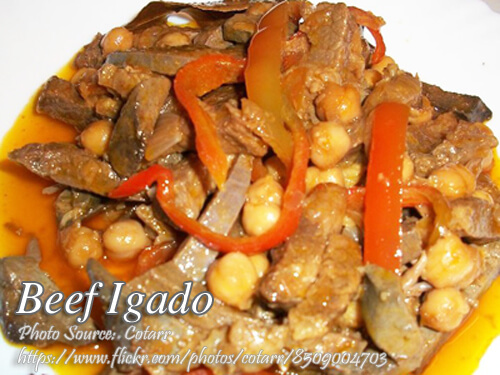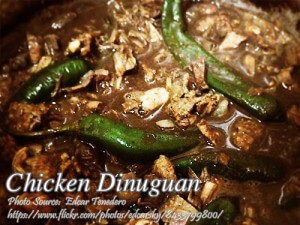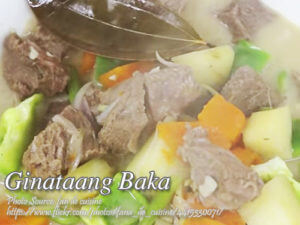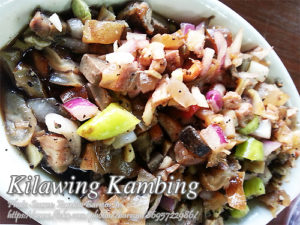Igado is an Ilokano dish and the original recipe consists of pig’s internal organs. If there is no available pork internal organs in your marketplace, or if you abstain from pork, you can try this beef igado recipe.
A Taste of Ilokano Cuisine
Beef igado is a savory Filipino dish that brings the rich flavors of the Ilocos region right to your dining table. Traditionally, Igado is made using pig’s internal organs, a true reflection of Filipino ingenuity in maximizing the use of every part of the animal. However, this beef version offers a delicious alternative for those who prefer or need to abstain from pork. The result is a hearty, flavorful dish that carries the essence of the original recipe while providing a more accessible ingredient list.
A Brief History of Igado
Igado traces its roots back to the Ilocos region in the northern part of the Philippines. This dish is deeply embedded in Ilokano culture, often served during special occasions and family gatherings. The name “Igado” is believed to come from the Spanish word “higado,” meaning liver, as the dish prominently features liver as one of its main ingredients. Traditionally, Igado is made with pork liver and other internal organs like the heart and kidneys, stewed in a vinegar-based sauce that gives it a distinct tangy flavor.
Over time, variations of Igado have emerged, catering to different preferences and dietary restrictions. This beef version, for example, retains the key elements of the dish—liver, heart, and a savory, tangy sauce—but substitutes beef for pork, making it an equally satisfying option for those who avoid pork or simply want to try a different take on a classic dish.
Preparing the Ingredients
The first step in preparing the igado is to ensure that the liver and heart are clean and free from any musky odor, known as “anggo” in Filipino. To do this, the liver and heart are boiled briefly, just enough to remove the odor but not to cook them fully. This step is crucial in maintaining the tender texture and rich flavor of the organ meats, which are central to the dish.
Once the liver and heart have been boiled and cleaned, they are sliced into thin strips, along with the beef. The slicing technique is important here, as it ensures that all the ingredients cook evenly and absorb the flavors of the sauce. The strips of meat should be uniform in size, which also adds to the dish’s visual appeal when served.
Building the Flavors
The next step in cooking the dish involves sautéing the garlic and onions until they become fragrant and slightly caramelized. This step is key to creating the base flavor for the dish. Once the garlic and onions are ready, the beef strips are added to the pan and stir-fried until the liquid evaporates. This helps to sear the beef, locking in its juices and giving it a nice, brown color that adds depth to the final dish.
After the beef has been seared, the liver and heart are added to the pan and stir-fried for a few more minutes. The brief cooking time ensures that the organ meats remain tender and don’t become tough or rubbery. At this stage, a small amount of water is added to the pan, allowing the ingredients to simmer together until they become tender.
Adding the Signature Tang
One of the defining characteristics of Igado is its tangy flavor, which is achieved by adding vinegar to the dish. After the beef, liver, and heart have simmered, vinegar is poured into the pan, along with a beef cube to enhance the savory taste. The vinegar not only adds a tangy kick but also helps to tenderize the meat further, creating a rich, flavorful sauce that coats every piece of meat.
To balance out the tanginess, pepper and laurel leaves (bay leaves) are added to the pan. These ingredients introduce a subtle, earthy note that complements the bold flavors of the dish. The key to a successful Igado is to allow the vinegar to cook off slightly, mellowing its sharpness and integrating it smoothly into the overall flavor profile.
Finishing Touches
The final steps in preparing it involve adding achuete (annatto) for color and stirring in chickpeas and bell pepper. The achuete not only gives the dish a beautiful reddish hue but also imparts a mild, nutty flavor that rounds out the dish. The chickpeas add a delightful texture, while the bell pepper provides a sweet contrast to the tangy and savory elements.
As the dish simmers for a few more minutes, all the flavors meld together, creating a rich, hearty stew that is both comforting and satisfying. Before serving, the dish is seasoned with salt or patis (fish sauce) to taste, allowing you to adjust the seasoning according to your preference.
A Hearty Dish for All Occasions
Beef igado is a dish that can be enjoyed on any occasion, whether it’s a simple family meal or a special gathering. Its rich, complex flavors are a testament to the ingenuity and resourcefulness of Filipino cuisine, where every ingredient is utilized to its fullest potential. This beef version offers a delicious and accessible alternative to the traditional pork-based recipe, making it a great option for those looking to explore the flavors of Ilocos in a new way.
As you savor each bite of this hearty stew, you’re not just enjoying a meal—you’re experiencing a piece of Filipino culture and history. Whether you’re a seasoned cook or a beginner in the kitchen, this is a dish that is sure to impress and satisfy. So, why not give it a try and bring a taste of Ilocos to your home?
How to Cook Beef Igado (Igadong Baka)
Ingredients
- 1/2 kilo beef
- 1/4 kilo beef heart
- 1/4 kilo beef liver
- 1 pc bell pepper sliced into strips
- 1/2 tsp. annato powder or Mama Sita Achuete
- 1/2 cup chickpeas or green peas
- 2 pcs laurel leaves
- 1/4 tsp. ground black pepper adjust if necessary
- 1/4 cup vinegar
- Salt or patis fish sauce to taste
- 1 pc beef broth cube
- 3 cloves garlic minced
- 1 pc medium size onion
Instructions
How to cook beef igado:
- Boil the heart and liver to remove the anggo or musky odor but don't cook it too much, just half cooked.
- Slice the beef, heart and liver into strips and separate the beef from the heart and liver.
- Saute garlic and onion then add the beef and stir fry for a few minutes until the liquid evaporates.
- Then add the heart and liver and stir fry for at least 3 minutes.
- Pour a little amount of water and simmer until the beef, heart and liver becomes tender.
- Add pepper and laurel leaves. When the liquid evaporates again, pour the vinegar and add the beef cube.
- Add the atchuete and stir for at least 3 minutes. Follow the chickpeas and bell pepper.
- Simmer again for at least 3 minutes and season with salt or patis.
- Adjust the amount of the salt or patis that suits your taste. Serve hot.
Notes
Cooking Tips:
Properly Prepare the Liver and Heart Before cooking, briefly boil the liver and heart to remove any musky odor, ensuring they are tender and not overcooked. This step is essential for maintaining the right texture and flavor in the final dish. Remember to slice the organ meats thinly to ensure they cook evenly with the beef. Sautéing for Depth of Flavor When sautéing the garlic and onions, let them cook until they become fragrant and slightly caramelized. This process builds a rich flavor base that enhances the taste of the meat and sauce. Stir-frying the beef until the liquid evaporates ensures the meat is well-seared, locking in its juices. Balance the Vinegar with Seasoning Add the vinegar gradually and let it simmer, allowing its sharpness to mellow and integrate with the other ingredients. Season the dish with pepper, bay leaves, and fish sauce or salt to balance the tangy flavor. Taste as you go to adjust the seasoning according to your preference, ensuring the flavors are well-rounded.






thank you for giving us easy to learn how to cook?